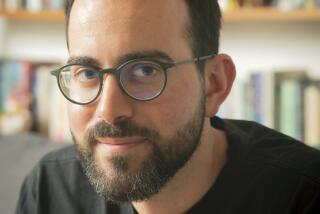The Polymath and the Pill : THE PILL, PYGMY CHIMPS, AND DEGAS’ HORSE: The Remarkable Autobiography of the Award-Winning Scientist Who Synthesized the Birth Control Pill, <i> By Carl Djerassi (Basic Books: $25; 307 pp.)</i>
- Share via
Carl Djerassi unabashedly calls himself an intellectual polygamist. At the beginning of the 1950s, when he was the associate director for research of Syntex, then a fledgling chemical firm in Mexico City, he led the team that synthesized the first oral contraceptive pill. During the next 20 years, he helped make Syntex a chemical powerhouse while earning a reputation as a leading steroid chemist, teaching on the Stanford University faculty, and becoming a wealthy man. Since the early 1970s, he has been a statesman of science, initiator of a conservation and research program in Zaire for the pygmy chimp, and a collector of art, including a horse sculpted by Degas.
In the 1980s, in the wake of a bitter, though as it turned out only temporary, disappointment in love, he began writing fiction, and recently he published his first novel, “Cantor’s Dilemma.” Now he has produced an autobiography that is part display, reporting his encounters with the makers and sellers of silk shirts and tailored jackets, but mostly picaresque adventure, in some ways outdoing fiction in the risks and improbabilities it describes, and in the discoveries--personal as well as scientific--that it recounts.
From its Middle European beginnings, Djerassi’s life was unorthodox. Much of his childhood was divided between summer months with his father, a bon vivant Bulgarian physician, and the school year with his mother, a Viennese doctor turned dentist. (The couple had divorced when he was 6 but neglected for many years to tell him.) At age 16, he and his mother came to the United States, Jewish refugees from Hitler, with little to sustain him except an outstanding school record and a dash of chutzpah.
Djerassi promptly wrote a letter to Eleanor Roosevelt asking for financial assistance to continue his education. The letter led, roundabout, to the award of a scholarship to Tarkio College in Tarkio, Mo., where, being perhaps the only Austrian-Bulgarian immigrant in the neighborhood, he lectured to church groups on the situation in Europe. He usually got paid from the collection plate, but on one occasion a Methodist minister deftly finessed the honorarium, which made Djerassi want to write another letter to the first lady: “Dear Mrs. Roosevelt, warn the President not to trust the Methodists.”
The Tarkio scholarship launched him on the path that led, in 1945, to a doctorate in chemistry from the University of Wisconsin, a stint with the CIBA pharmaceutical company, and, in 1949, to a position at Syntex. The firm, whose name was meant to evoke “synthesis” and “Mexico,” recently had been founded by a renegade chemist who had been unable to interest any American firms in inedible yams--or rather in the group of steroid compounds found in certain kinds of the plants, which grow wild in Mexico. Friends advised Djerassi against casting his lot with a small upstart company in a scientific backwater. But Djerassi, who wanted an eventual academic career, was attracted to the company because it aspired, as he did, to an outstanding scientific reputation.
Djerassi compellingly relates the chemical strategy that Syntex followed to produce the oral contraceptive and build its fortune. His tale is a classic study of how scientific boldness--the willingness to explore uncertain but intriguing avenues--can yield big payoffs in technological innovation and market competitiveness.
No less absorbing is his story of how Syntex, whose headquarters followed Djerassi to Palo Alto in the early 1960s, spun off two profitable new companies: Syva, which imaginatively exploited techniques to detect trace chemicals in, say, blood or urine; and Zoecon, which concocted environmentally benign pesticides out of synthetic insect hormones.
The research programs of both firms relied on knowledge obtained from consultations with faculty at Stanford. Djerassi himself, with the endorsement of the Stanford provost, wore two hats: professor and executive vice president for research at Syntex. The arrangements all fell perfectly within Stanford’s rules, and Djerassi typically celebrates the success of Syva as “a first-class example of the synergy generated when the interplay between academia and industry is allowed to proceed in an enlightened environment.”
Such a consistently cozy relationship between industry and academe can, of course, become corrupting. For example, the needs of the corporation can overshadow those of the academy, thereby exploiting graduate students and discouraging openness in the professor’s laboratory for fear of revealing proprietary secrets.
Djerassi neglects such issues. But his inattentiveness is explicable, if regrettable, on grounds that he himself ran an active academic research program, cared for his students, and devoted a lot of time to teaching, devising a variety of innovative and effective pedagogical methods.
Djerassi remarks that an autobiography is like Swiss cheese--inevitably there will be holes, some crafted consciously, others not. Neither friends nor family members are woven into these pages as continuing vital presences. For the most part, they appear as intellectualized cameos. Their remoteness is perhaps an artifact of temperament, what he describes as a tendency for years to closet himself behind thick walls of privacy. Yet it is also likely a sign of the pain that has marked his personal relationships. He has divorced twice. And his daughter, Pamela, who was an artist, committed suicide.
In a moving chapter, Djerassi writes delicately about the tragedy, recounting how he tried to make sense of it with the help of his third wife, the poet and literary scholar Diane Middlebrook, and how it stimulated him to move from collecting art to helping living artists. The move to patronage led to the creation of a highly successful artist’s colony, initially supported by the Djerassi Foundation and now by other philanthropies as well, that is centered on what had been Pamela’s home in the wooded, low-lying mountains behind Palo Alto. “If only . . . your death had not been necessary before I took seriously the patronage of the living,” he laments, addressing his daughter.
Chemistry is no longer at the center of his life, yet he obviously continues to relish it, describing with lucid accessibility branches of the science that have absorbed him. He has little to say about actual chemical practice, perhaps because he left the laboratory bench in 1952 to become an innovator and manager of research programs.
But often just in passing he tosses out fascinating oddments about chemicals--their structural relationships, their role in vital processes, and how such intricacies can be exploited for social benefit and commercial profit. An early Zoecon product, for example, managed to reduce the horn-fly population by mixing a growth-retarding hormone into cow feed, thus converting the cow itself, which safely passes the hormone, into a means of delivering the insect-controlling chemical to the pasture.
He also advances a sustained, provocative analysis of the halt of contraceptive research in the United States since the 1970s. In his contention, the culprits have been misunderstandings about clinical trials, attacks by some feminists, and product-liability suits, all of which have combined to make contraception here a field of political combat rather than a research effort toward revolutionary methods such as an antifertility vaccine or a male pill.
Its few holes notwithstanding, Djerassi’s autobiographical Swiss cheese contains plenty to chew on, and much that is sharp and tangy.
More to Read
Sign up for our Book Club newsletter
Get the latest news, events and more from the Los Angeles Times Book Club, and help us get L.A. reading and talking.
You may occasionally receive promotional content from the Los Angeles Times.







